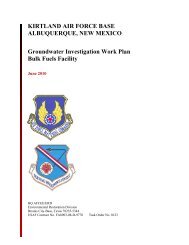Final FONSI and EA for hot cargo pad on Kirtland AFB - Kirtland Air ...
Final FONSI and EA for hot cargo pad on Kirtland AFB - Kirtland Air ...
Final FONSI and EA for hot cargo pad on Kirtland AFB - Kirtland Air ...
You also want an ePaper? Increase the reach of your titles
YUMPU automatically turns print PDFs into web optimized ePapers that Google loves.
making improvements in management techniques, training, <str<strong>on</strong>g>and</str<strong>on</strong>g> inventory c<strong>on</strong>trol. C<strong>on</strong>sistent with<br />
polluti<strong>on</strong> preventi<strong>on</strong> principles, EO 13423, Strengthening Federal Envir<strong>on</strong>mental, Energy, <str<strong>on</strong>g>and</str<strong>on</strong>g><br />
Transportati<strong>on</strong> Management (January 24, 2007 [revoking EO 13148]) sets a goal <str<strong>on</strong>g>for</str<strong>on</strong>g> all Federal agencies<br />
that promotes envir<strong>on</strong>mental practices, including acquisiti<strong>on</strong> of biobased, envir<strong>on</strong>mentally preferable,<br />
energy-efficient, water-efficient, <str<strong>on</strong>g>and</str<strong>on</strong>g> recycled-c<strong>on</strong>tent products, <str<strong>on</strong>g>and</str<strong>on</strong>g> use of paper of at least 30 percent<br />
post-c<strong>on</strong>sumer fiber c<strong>on</strong>tent. In additi<strong>on</strong>, EO 13423 sets a goal that requires Federal agencies to ensure<br />
that they reduce the quantity of toxic <str<strong>on</strong>g>and</str<strong>on</strong>g> hazardous chemicals <str<strong>on</strong>g>and</str<strong>on</strong>g> materials acquired, used, or disposed<br />
of, increase diversi<strong>on</strong> of solid waste as appropriate, <str<strong>on</strong>g>and</str<strong>on</strong>g> maintain cost-effective waste preventi<strong>on</strong> <str<strong>on</strong>g>and</str<strong>on</strong>g><br />
recycling programs in their facilities. Additi<strong>on</strong>ally, in Federal Register Volume 58 Number 18 (January<br />
29, 1993), CEQ provides guidance to Federal agencies <strong>on</strong> how to “incorporate polluti<strong>on</strong> preventi<strong>on</strong><br />
principles, techniques, <str<strong>on</strong>g>and</str<strong>on</strong>g> mechanisms into their planning <str<strong>on</strong>g>and</str<strong>on</strong>g> decisi<strong>on</strong>making processes <str<strong>on</strong>g>and</str<strong>on</strong>g> to evaluate<br />
<str<strong>on</strong>g>and</str<strong>on</strong>g> report those ef<str<strong>on</strong>g>for</str<strong>on</strong>g>ts, as appropriate, in documents pursuant to NEPA.”<br />
The Resource C<strong>on</strong>servati<strong>on</strong> <str<strong>on</strong>g>and</str<strong>on</strong>g> Recovery Act (RCRA) of 1976 is an amendment to the Solid Waste<br />
Disposal Act. RCRA authorizes USEPA to provide <str<strong>on</strong>g>for</str<strong>on</strong>g> “cradle-to-grave” management of hazardous<br />
waste <str<strong>on</strong>g>and</str<strong>on</strong>g> sets a framework <str<strong>on</strong>g>for</str<strong>on</strong>g> the management of n<strong>on</strong>hazardous municipal solid waste. Under RCRA,<br />
hazardous waste is c<strong>on</strong>trolled from generati<strong>on</strong> to disposal through tracking <str<strong>on</strong>g>and</str<strong>on</strong>g> permitting systems, <str<strong>on</strong>g>and</str<strong>on</strong>g><br />
restricti<strong>on</strong>s <str<strong>on</strong>g>and</str<strong>on</strong>g> c<strong>on</strong>trols <strong>on</strong> the placement of waste <strong>on</strong> or into the l<str<strong>on</strong>g>and</str<strong>on</strong>g>. Under RCRA, a waste is defined<br />
as hazardous if it is ignitable, corrosive, reactive, toxic, or listed by USEPA as being hazardous. With the<br />
Hazardous <str<strong>on</strong>g>and</str<strong>on</strong>g> Solid Waste Amendments (HSWA) of 1984, C<strong>on</strong>gress targeted stricter st<str<strong>on</strong>g>and</str<strong>on</strong>g>ards <str<strong>on</strong>g>for</str<strong>on</strong>g> waste<br />
disposal <str<strong>on</strong>g>and</str<strong>on</strong>g> encouraged polluti<strong>on</strong> preventi<strong>on</strong> by prohibiting the l<str<strong>on</strong>g>and</str<strong>on</strong>g> disposal of particular wastes. The<br />
HSWA amendments strengthen c<strong>on</strong>trol of both hazardous <str<strong>on</strong>g>and</str<strong>on</strong>g> n<strong>on</strong>hazardous waste <str<strong>on</strong>g>and</str<strong>on</strong>g> emphasize the<br />
preventi<strong>on</strong> of polluti<strong>on</strong> of groundwater.<br />
The Superfund Amendments <str<strong>on</strong>g>and</str<strong>on</strong>g> Reauthorizati<strong>on</strong> Act (SARA) of 1986 m<str<strong>on</strong>g>and</str<strong>on</strong>g>ates str<strong>on</strong>g clean-up<br />
st<str<strong>on</strong>g>and</str<strong>on</strong>g>ards <str<strong>on</strong>g>and</str<strong>on</strong>g> authorizes USEPA to use a variety of incentives to encourage settlements. Title III of<br />
SARA authorizes the Emergency Planning <str<strong>on</strong>g>and</str<strong>on</strong>g> Community Right to Know Act (EPCRA), which requires<br />
facility operators with “hazardous substances” or “extremely hazardous substances” to prepare<br />
comprehensive emergency plans <str<strong>on</strong>g>and</str<strong>on</strong>g> to report accidental releases. If a Federal agency acquires a<br />
c<strong>on</strong>taminated site, it can be held liable <str<strong>on</strong>g>for</str<strong>on</strong>g> cleanup as the property owner/operator. A Federal agency can<br />
also incur liability if it leases a property, as the courts have found lessees liable as “owners.” However, if<br />
the agency exercises due diligence by c<strong>on</strong>ducting a Phase I Envir<strong>on</strong>mental Site Assessment, it can claim<br />
the “innocent purchaser” defense under CERCLA. According to Title 42 United States Code (U.S.C.)<br />
9601(35), the current owner/operator must show it undertook “all appropriate inquiry into the previous<br />
ownership <str<strong>on</strong>g>and</str<strong>on</strong>g> uses of the property c<strong>on</strong>sistent with good commercial or customary practice” be<str<strong>on</strong>g>for</str<strong>on</strong>g>e<br />
buying the property to use this defense.<br />
The Toxic Substance C<strong>on</strong>trol Act (TSCA) of 1976 c<strong>on</strong>sists of four titles. Title I established requirements<br />
<str<strong>on</strong>g>and</str<strong>on</strong>g> authorities to identify <str<strong>on</strong>g>and</str<strong>on</strong>g> c<strong>on</strong>trol toxic chemical hazards to human health <str<strong>on</strong>g>and</str<strong>on</strong>g> the envir<strong>on</strong>ment.<br />
TSCA authorized USEPA to gather in<str<strong>on</strong>g>for</str<strong>on</strong>g>mati<strong>on</strong> <strong>on</strong> chemical risks, require companies to test chemicals<br />
<str<strong>on</strong>g>for</str<strong>on</strong>g> toxic effects, <str<strong>on</strong>g>and</str<strong>on</strong>g> regulate chemicals with unreas<strong>on</strong>able risk. TSCA also singled out polychlorinated<br />
biphenyls (PCBs) <str<strong>on</strong>g>for</str<strong>on</strong>g> regulati<strong>on</strong>, <str<strong>on</strong>g>and</str<strong>on</strong>g>, as a result, PCBs are being phased out. PCBs are persistent when<br />
released into the envir<strong>on</strong>ment <str<strong>on</strong>g>and</str<strong>on</strong>g> accumulate in the tissues of living organisms. They have been shown<br />
to cause adverse health effects <strong>on</strong> laboratory animals <str<strong>on</strong>g>and</str<strong>on</strong>g> could cause adverse health effects in humans.<br />
TSCA <str<strong>on</strong>g>and</str<strong>on</strong>g> its regulati<strong>on</strong>s govern the manufacture, processing, distributi<strong>on</strong>, use, marking, storage,<br />
disposal, clean-up, <str<strong>on</strong>g>and</str<strong>on</strong>g> release reporting requirements <str<strong>on</strong>g>for</str<strong>on</strong>g> numerous chemicals like PCBs. TSCA Title II<br />
provides statutory framework <str<strong>on</strong>g>for</str<strong>on</strong>g> “Asbestos Hazard Emergency Resp<strong>on</strong>se,” which applies <strong>on</strong>ly to<br />
schools. TSCA Title III, “Indoor Rad<strong>on</strong> Abatement,” states indoor air in buildings of the United States<br />
should be as free of rad<strong>on</strong> as the outside ambient air. Federal agencies are required to c<strong>on</strong>duct studies <strong>on</strong><br />
the extent of rad<strong>on</strong> c<strong>on</strong>taminati<strong>on</strong> in buildings they own. TSCA Title IV, “Lead Exposure Reducti<strong>on</strong>,”<br />
directs Federal agencies to “c<strong>on</strong>duct a comprehensive program to promote safe, effective, <str<strong>on</strong>g>and</str<strong>on</strong>g> af<str<strong>on</strong>g>for</str<strong>on</strong>g>dable<br />
A-9
















